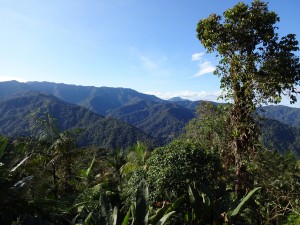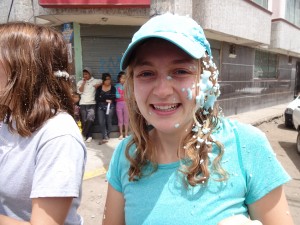We got back from an excursion to the Cloud Forest several days ago. We were very busy, our days started at 6 am with birding and finished at 9 pm with light traps for moths. Despite the overall busyness, I found a few quiet moments to think and reflect. Here is an excerpt from my field notebook reflecting about time:
During our excursion I thought a lot about time, how we measure time, and what time means to me. I felt like life at Santa Lucia was a different pace, but I couldn’t tell you if it was slower or faster. It was just different. The moments I spent on the deck staring at the valley felt eternal and hikes through the rain felt (happily) never-ending. Time passed differently during candle lit dinners and talks on the hammocks.
I didn’t wear a watch before coming to Ecuador. I never felt the need to. My days were structured and I could always hear the clock tower ring every half hour on Whitman campus. Here, I embrace the structure that my watch presents. I feel more in control in a world that is moving very quickly.
During the drop off in the forest I found myself thinking about time. How does time pass for animals and plants? Do they have a sense of time? I realized that without my watch, I would have no way of knowing when I was supposed to head back to the lodge. It was a cloudy, rainy afternoon and I was under large trees. I couldn’t see the sun or any shadows. In that moment I was glad that I had my watch, because I hate being late, but I also realized that I missed an important part of the drop off. I wanted to immerse myself in the forest, listen to the sounds of the birds, and feel the rain on my skin. Instead, I looked at my wrist every five minutes to make sure I would be on time for dinner. I am excited for our next drop off in the Amazon. My goal is to focus on being in the present, allowing time to flow, and not to worry about the meaningless numbers on my wrist.
I greatly enjoyed the days we spent in Yunguilla, a rural town of 200 people, and I had a different interaction with time there. Time didn’t matter, the roosters woke us up to milk the cows and our stomachs told us when it was time to eat. My host sister got home from school sometime in the afternoon and then we would play basketball and dance like fools in the living room. A community gathering at 8:00 pm meant “sometime around 8, 8ish.” I’m not going to lie; it was an adjustment at first. I am accustomed to schedules and routines. Anything new is different, but I found that I enjoyed just letting time flow around me like water.
So far in Ecuador I have had two very distinct relationships with time. There’s the fear of time, the fear of being late that keeps my eyes constantly glued to my watch. That Hannah is worried about being late to school because the bus was full and didn’t stop at her stop. The other Hannah loves mornings spent outside, too distracted to care about time. I know that my interactions with time will constantly change during the rest of my time in Ecuador, but I hope that I will be able to live in the moment and just let time happen.







